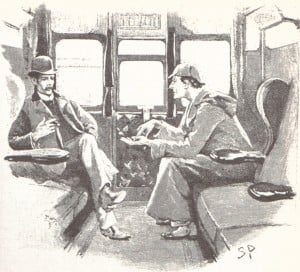We begin part four of our Sherlock Holmes documentary with a visit to the building, on London’s Upper Wimpole Street, where Dr. Arthur Conan Doyle had set himself up as a medical practitioner when, due to a distinct lack of patients, he bagn tinkering with the characters of Sherlock Holmes and Dr. John Watson.
A New Kind of Story
Having seen his first Holmes adventure, A Study In Scarlet published, appear in print, Conan Doyle had the idea to follow it up with a completely new style of story that would make publishing history and would, effectively, create the World’s first soap opera.
This new style would be a series of short stories that would be based upon, and centred around, a central character and, as such, it would be the forerunner of the modern day detective television programmes, such as CSI.
Interest in Holmes and Watson Rocketed
It was this short story style that caused interest in Holmes and Watson to sky rocket and soon the Strand Magazine, in which the stories were appearing, was enjoying sales of close on 500,000 copies.
A New Type of Citizen

The success of the stories was also aided by the fact that a new “type” of citizen had, by this time, emerged – the commuter.
As London began to expand, the Strand Magazine was able to pitch itself at a whole new class of readership who could now pass their journey time by reading the latest adventures of Holmes and Watson.
There was also the fact that people could now enjoy reading the stories at night by gaslight, as houses were no starting to enjoy the luxury of illumination.
As the first double act detectives, Holmes and Watson captured the public imagination in a way that no other character, or characters, had done in the past.
The Birth Of Modern Crime Drama
But Conan Doyle’s influence would be far reaching and continues to entertain audiences today with the modern day detective programmes still adhering to a formula that was originated by Arthur Conan Doyle.
Indeed, if you pause for a moment and picture virtually any modern day crime show – such as CSI or NCIS, to name but two – the progression of the story lines, together with the deductive reasoning demonstrated by the protagonists, and which is such an integral part of each show, still follows closely to a blue print that was laid down over 120 years ago by Arthur Conan Doyle.
The Godfather of Crime Fiction
His formula, if you think about it, is, well and truly, immortal!
As Sherlock Holmes expert Dr Antony J. Richards puts it in our documentary “it wouldn’t be unfair to say that Conan Doyle is the father, if not the godfather, of all modern detective fiction.”
Cunning, Believable Villains
Another aspect of the Sherlock Holmes stories, that we comment upon in the documentary, is the fact that many of Conan Doyle’s villains are as cunning as the great detective himself. Many of the villains are, for example, aristocratic and, therefore, seemingly respectable figures who should, in theory at least, be helping make society a better place and keep it safe, but who are, in fact seeking to destroy it.
The most famous example of this is, of course, Moriarty, an almost mythical figure, whose influence and presence are often more sensed than seen.
But, and harking back to Doyle’s own childhood experiences, the thoroughly bad characters in the Holmes stories are perpetrators of domestic violence, some of them driven by alcoholism, but all of them perhaps more disturbing to modern day readers than the likes of Professor Moriarty with his ingenious schemes.
Sherlock Holmes and Jack the Ripper
Of course, as the rise in the popularity of Holmes and Watson coincided almost exactly with the emergence from the London shadows of a very real evil villain, who escapades were striking terror into the hearts and minds of the Victorian public.
That villain was Jack the Ripper, and his East End escapades, and the subsequent reporting of them, were giving people a taste for the nefarious World of ‘orrible murder.
With the real guardians of the peace, the London police, seemingly unable to track down the unknown miscreant who was carrying out the Whitechapel Murders on the streets of the East End of London, Holmes, in certain respects, served to reassure people that there were bad things happening, but they can be dealt with.
